Baltimore Parking Meter
Baltimore Police Meter Maids

A Meter Maid unit began on 8 May of 1961 with 10 Meter Maids and a Sergeant. Prior to that on 1 November 1955, The Baltimore Police department Traffic Enforcement unit enforced parking meter violations. The first Meters went up on North Ave. after 48 days the meters had made a profit of a little more than $29K. $29K in 1955 would be around $275,000.00 in 2019
Baltimore City Parking Meter / Meter Maid Timeline History
1937 – A bill was introduced in City Council to bring Parking Meters to Baltimore (Police Commissioner Lawson opposed the bill favoring instead off street parking. He argued Curb parking would increase the traffic problems downtown.
1955 – 1 November 1955 - After nearly 20 years and four police commissioners arguing for and against Parking meters; Parking meters are finally signed into law and on 1 Nov 1955 the first parking meter was installed and went into use on North Ave in Baltimore City. These meters were enforced by Baltimore Police department's Traffic Enforcement Section.
1961 – 8 Mar 1961 - The Baltimore City Police Meter Maid Section formed within the department's Traffic Enforcement Section.
1980 – The Meter Maids separate from the department and go to the Department of Transportation where they would remain until 2001
2001 – Meter Maids now called Parking Control Agents and work for Parking Authority of Baltimore City.
This information is still being updated and verified
Factoid: When you insert a coin in the meter and begin to turn the handle you will see a yellow "VIOLATION" flag comes up. What's cool about these "VIOLATION" flags is there is a serial number on them that is unique to the machine. If a coin does not fully cycle through the meter the violation flag will remain up and give the meter maid a reference to that meter's mechanism. A work order to repair it would be generated using that mechanism serial number. At least that is the way they were used in most cities. Baltimore also had a metal band that wrapped around the pole that held them, this number was used both by the meter maid, and a citizen to report a broken meter or a meter in violation.
Also, regarding the sticker on the front of the meter that usually says "POLICE WILL NOT TURN HANDLE," or something to that effect. This is where the criminal mind comes into play. People thought if they had a 2 hr parking limit they would just insert additional coins and not cycle them through the meter. They would then expect the meter maid or police officer to turn the handle for them should they show up and see the time has expired. They called it "Re-feeding" the meters and of course, that was illegal to do. So it was just a "parking beware" warning. In Baltimore we have people that will feed your meter for you, in return you give them a tip, a hard fault, highly demanded "Aggressive Panhandler type Tip" Often the driver would put the coins in the meter so the parker would only have to turn the handle in say an hour or just as the meter was about to expire. Often these parkers would cross a line of an aggressive panhandler, into the realm of strong arm robbery. That's why we have so many laws. Thanks again to Dennis Kohl

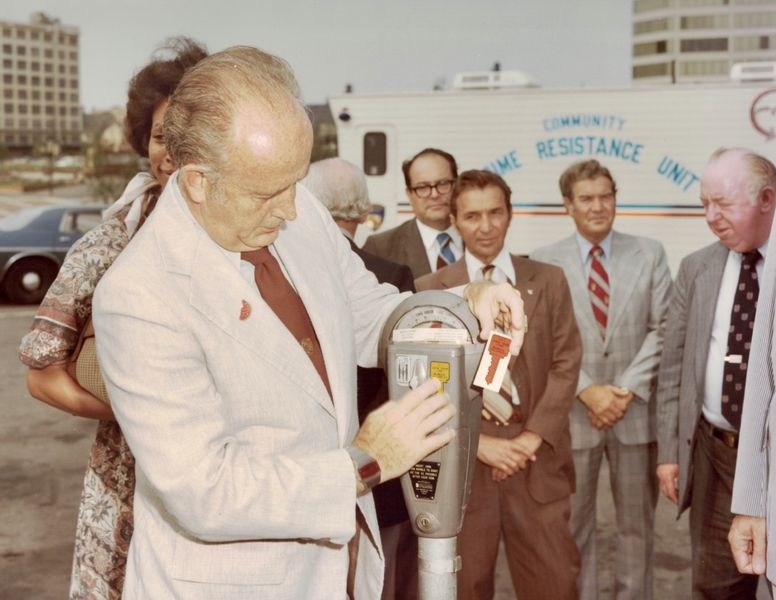
This was a part or the Lock Your Car Program. Police Agent Bob Douglas put thousands of decals on meters. The decals were designed by Officer Pete Katich. Cathy Pugh is standing behind the Mayor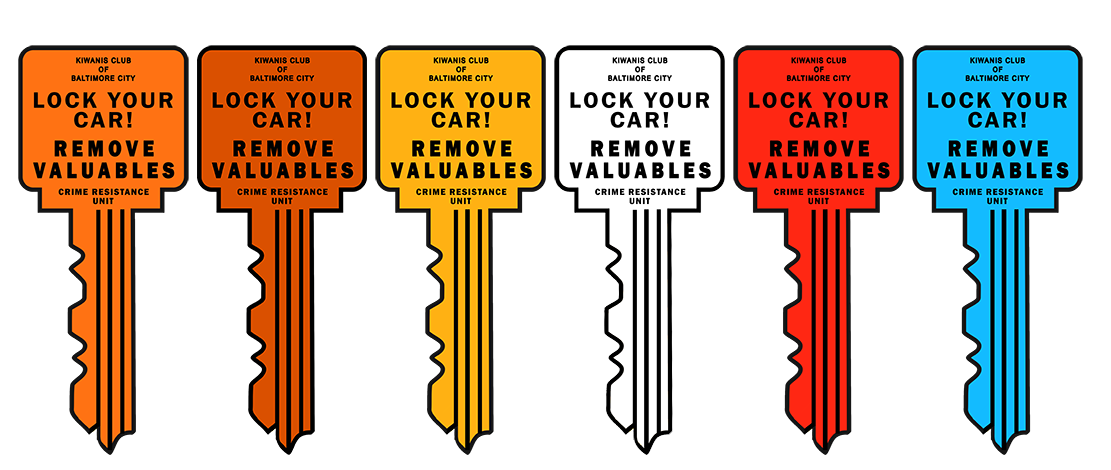
We remade the decals to put on our parking meters for use on our display to tell not only how the Parking meter unit started in the Baltimore Police Department, but then the Lock Up and Remove Your Valuables program developed by our Crime Resistance Unit in order to hopeful reduce the number of Theft from Autos .
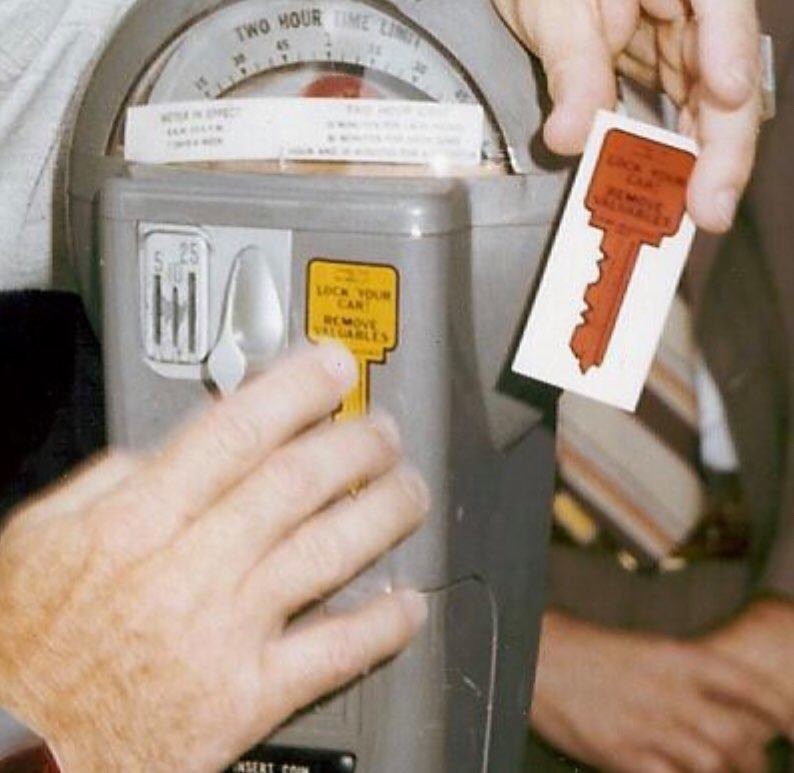
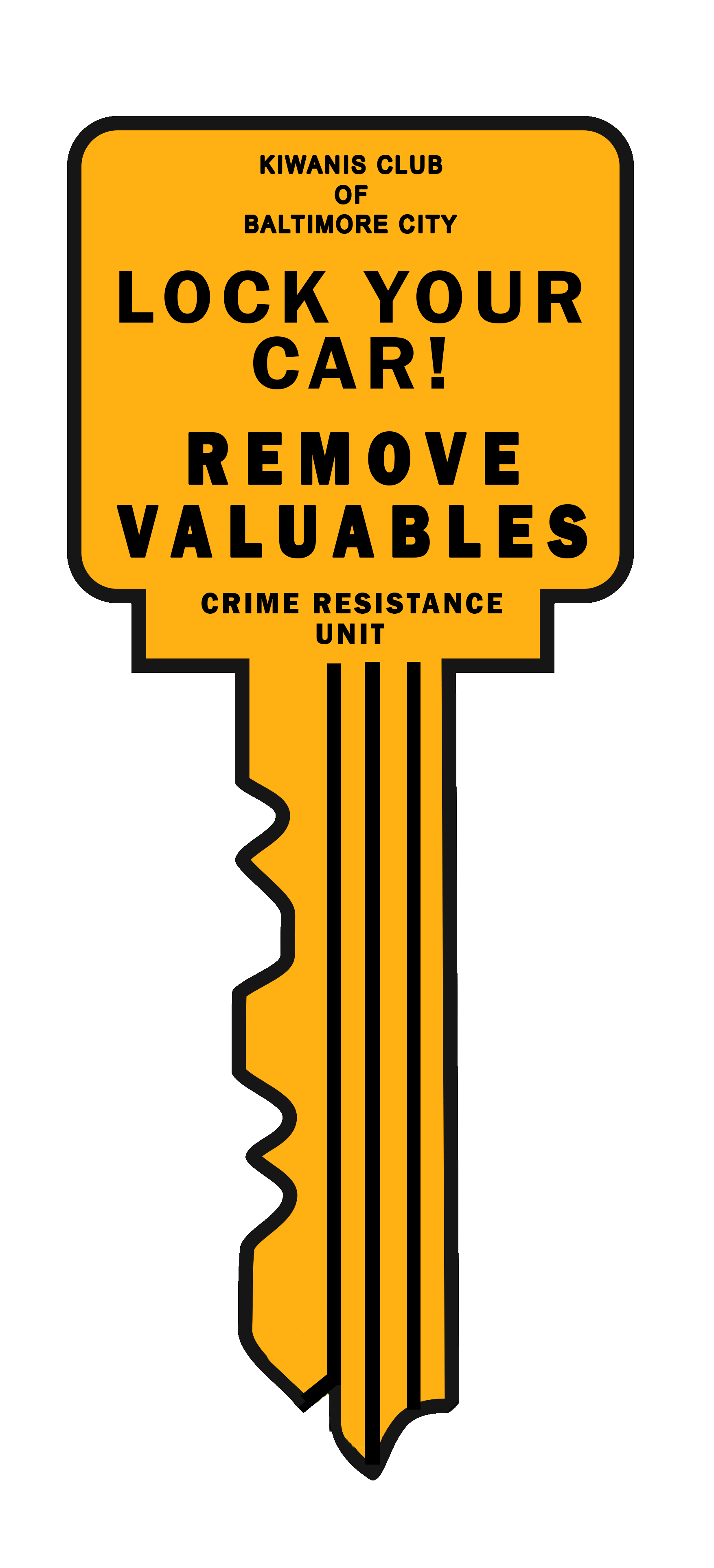
Full size example of one of the Keys we drew for the Parking Meters
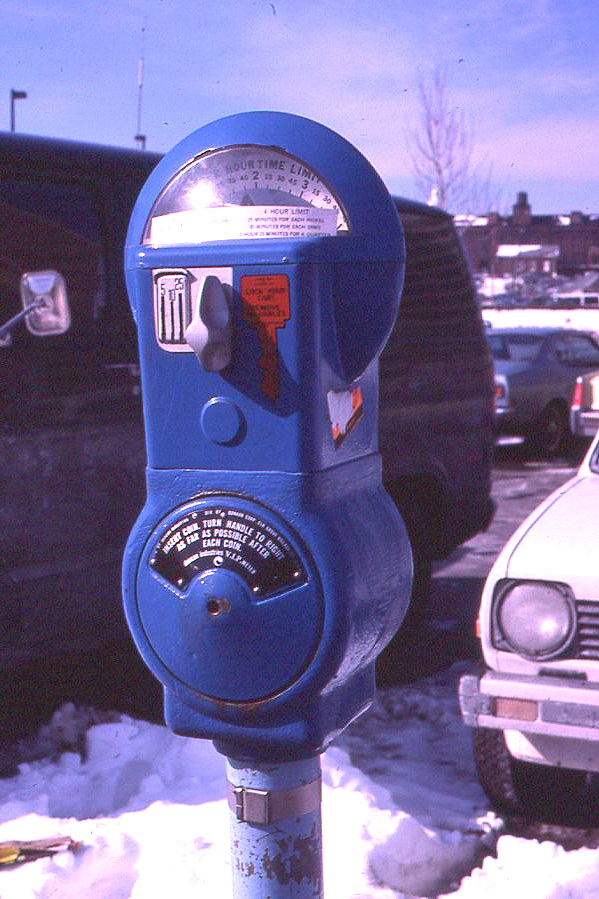
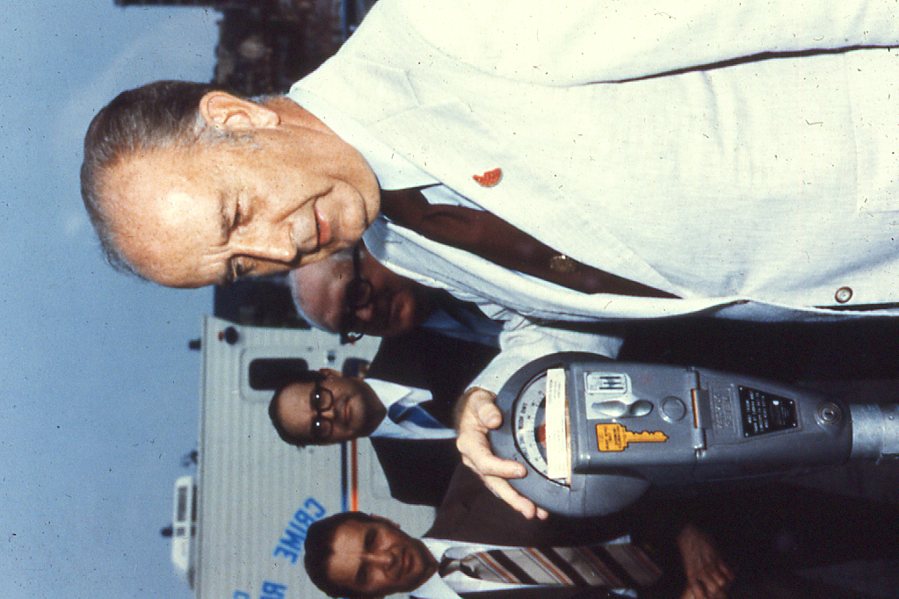

Blue Hand The Badge of Meter Maids
26 May 1963
Reported by James Waesche
Just because she’s pretty, just because she looks sharp in her fitted coat, culottes, and high heels, don’t think you can sweet talk her out of a parking ticket she’s about to stick under your car's wiper blade. No, sir. With a meter maid, it's “strictly,” emphasizes Mrs. Shirley Kurtz one of Baltimore’s original ten Meter maids. She demonstrated.
Pleading Futile
Spotting a meter with its red flag up Mrs. Kurtz effortlessly maneuvered her white compact patrol car into a nearby space. She grabbed her summons book and marched to the illegally parked car. First, she compared its license number with the numbers on her list of stolen cars (called a Hot Sheet – If it had been listed as stolen she would have radioed police headquarters and not tagged the car.) She also checked it the front and rear tags matched. Writing the summons took only a minute; sliding it under the wiper blade second. She was about to leave when the owner of the car appeared. “ma’am…” Yes, sir?” “I was just this minute coming out here to put a nickel.. uh, to put another nickel… in that meter. It just ran out. Could You…” - “You should watch your time more closely, sir,” Mrs. Kurtz admonished, smiling. ”But it just this second…” “ Really you should, sir” “I…” But Mrs. Kurtz had turned and was returning to her car. With her she was carrying the crumpled carbon paper she had torn from between the summons sheets (a carbon-blue hand is the badge of an efficient meter maid). In her car, she stuffed the carbon into a litter bag she carries specifically for that purpose and drove off. It had been a simple, routine process. It might not have been. “The majority of people are nice, Mrs. Kurtz said. Sometimes, however, a meter maid will meet a driver who is anything but “nice,” Such a driver-man or woman can be anything from slightly rude to downright obstreperous. Hardly ever, though, is he actually violent.
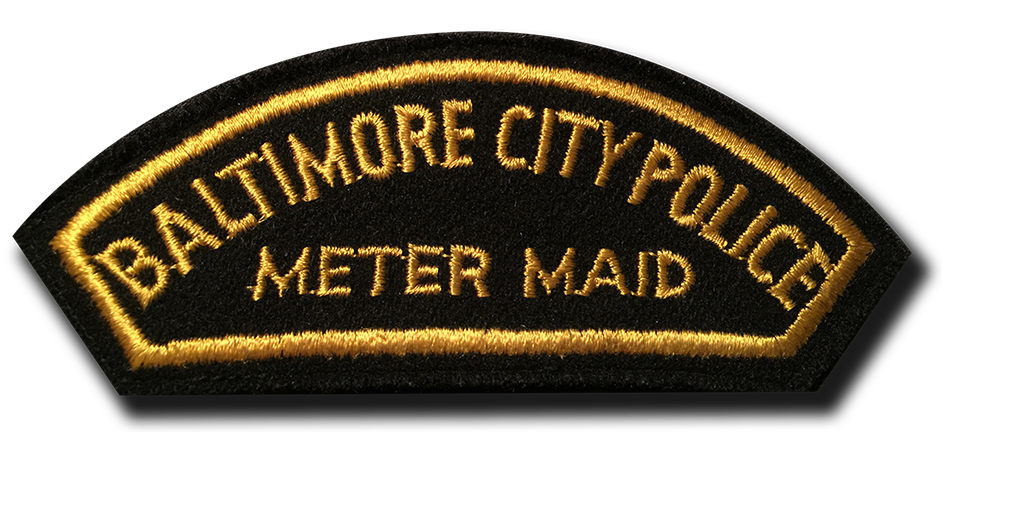
Sparks Bitterness
“probably more momentary bitterness results from a parking summons than from any other type violation.” Says the Sergeant. “When a person robs a bank, he knows he is guilty of a crime, but with a parking meter violated, it’s just a matter of forgetting a nickel, or “I was just leaving,” or: I’ve been unloading.” Or “The meter is broken.” Oh, we’ve heard them all.”
Meter maids are trained to handle any type of personality they might encounter. “They’re instructed to be courteous, considerate. A reasonable but firm,” Sergeant Wooden says, This works quite well with the average motorist, but if a person becomes nasty, a meter maid will simply get into her patrol car and drive away. Leaving the angry offender to cool off and to further contemplate the summons, which she doesn’t take with her when she leaves.
Meter maids do not have the power to arrest. They have only the authority to tag parking violators. “they never go into a house,” says Sergeant Wooden, “obviously. They’re unarmed, so as soon as they get in they could be in trouble, They’ve no way of telling what is on the other side of that door.”
In such a situation that is, if someone approaches it calls a meter maid for he-she may only ask what the nature of the trouble is, then relay the message to the police dispatcher. He will then send the required assistance.
Aid In Accidents
A meter maid may, however, assist in a traffic accident. First, she radios the dispatcher and, if a victim needs first aid, she applies it. She also may direct traffic, if necessary, until a policeman arrives.
First aid is one of many subjects the maids study thoroughly during the two-week course at the police academy. They are also given an orientation program to familiarize them with the structure of the police department and with the functions of its numerous sections. They receive instructions from judges on courtroom procedures as sometimes they have to testify in the traffic court. They are taught to use their car radio, and they are put through a driver- training program. They also take courses in the care and maintenance of their patrol cars.
Each meter maid is assigned a car. Every morning after they receive their assignments from Sgt Wooden, they march from their briefing room to the parking lot. There they get a final review of orders and they get a final review of orders and they conduct an equipment check. Call box key, L-shaped aluminum chalk holder with which to mark tires of vehicles in time zones, summons books and stolen auto hot sheets.
They look at the tires of their cars (No! they don’t kick them.) They examine the finish of the car, and if it is scratched or scarred, they tell the sergeant. They even lift car hoods and check-albeit gingerly-the oil and water. On a signal from Sergeant Wooden, they start their cars and drive out to begin their patrol of Baltimore’s 8400 parking meters.
Rooketic Training
Usually, the maids travel singly. Periodically, however, they ride in pairs. This is one during the three-day field training period which follows the classroom work at the Academy. For these three days a novice, or rookette,” ride with one of the senior maids… (“We don’t call them “the old maids,” warns their instructor, Lt James B Mills.)
The senior mid drives the first round of the day's post, then she lets the rookette take the wheel and the summons book. Riding with Mrs. Kurtz, who has been with the program since it began in May 1961 was Mrs. Angela M Chaney. Like Mrs. Kurtz Mrs. Chaney is the mother of two (seventeen of the cities twenty-meter maids are married), And, like Mrs. Kurtz, she has a genuine enthusiasm for her unusual job. Before she became a meter maid, Mrs. Chaney was a demonstrator of kitchenware, “But,” she says, “I wanted to do a job that means something
The First Day
Mrs. Kurtz, too. Is dedicated to the Job because of its social significance, but she was originally attracted to t as it was something novel and exciting. Mrs. Kurtz says that three of their friend tried out for the position with the then-experimental group. Among them it was like a contest a challenge,” she says, “I would have died if I hadn’t made it.” But she did make it, as did her friends.
Lieutenant Mills remembers the first day of the operation the day the regional ten maids first went out after months of preliminary hassling over things like official designation (They are called Parking Meter Special Police Women), legal authority for the establishment of the force, and the type of costume (someone kept insisting on slacks).
“The first day they went out, it was one of those all-day rains typical of May,” the Lieutenant recalls. When they returned that evening their hair was all soaked and I thought, “Well, we’ll see no more of them.” But I was wrong. The next day they were all back.”
In its first two years, the program has been quite successful. In one month-22 working days of eight hours, each one-meter maid dispenses between 600 to 700 tickets, according to sergeant wooden. Last year, the meter maids issued 68,515 summons. The burden shouldered by the patrolmen has thus been immeasurably lightened by the ladies in blue.
On Straight Salary
If a meter maid tags a car, the owner stands to pay a fine of $2.50 or $5.50. depending on the location of the vehicle's violation. And, if it is tagged while parked by the stadium during an event there, the penalty is $10.50
The meter maids do not collect coins from the meters. That is the function of a special collection agency. They work from 10 am til 6 PM weekdays and from 8 am until 4 pm on Saturdays. Their schedule is rotated to permit them, in addition to Sunday, one day a week off.
Contrary to what some people think who have been ticketed often think, meter maids are not paid on a sort of 25-cent-per-summons incentive basis. They earn a straight salary, which starts at $3,492 and increases over a six-year period to $4,404. Uniforms are furnished by the department, but each maid must buy her own shirt, tie, and shoes.
They are forbidden to wear flats, “Regulations,” states sergeant wooden, officially. “They don’t look as good,” Adm Lieutenant Mills.
Use little makeup
Meter maids must be between 21 and 30 years old. They have to be over 5-foot-2, but can’t stop 6 feet. They may wear makeup if it is sparingly applied, ”no green eye-shadow,” Lieutenant Mills says. Hairdos may be individualistic, but sensible. It would be difficult, obviously, to attempt to enforce the law while wearing, one’s visored police cap perched atop a high, sculptured coiffure.
Meter maids differ from regular police in that they wear uniforms (policewomen are always in plainclothes), not carry weapons, and lack the powers of arrest. Thus differs from crossing guards, on the other hand, by being full-time employees, of the police department and by being actual enforcement agents.
Started as a “pilot project,” according to Lieutenant Mills, the meter maids, now beginning their third year with double their original woman power, seem to be well on their way to group permanence. “we have been successful with it so far.” Lieutenant Mills said.

Mrs. Shirley Kurtz
Meter Maid
Meter Maid 1961 Baltimore Police. all of these are of Mrs. Shirley Kurtz She was one of the first 10 meter maids hired by the Baltimore Police department at the start of their using parking meters in Baltimore which was 1 Nov 1958 - initially enforced by our Traffic Division, until 8 May 1961 when they started using the newly formed meter maids. It was odd as it was at that time they were merging Park Police into the department so they didn't want a third department, eventually, they would separate meter maids from the police department. Some were asking the difference between Meter maids and Crossing guards at the time because their uniforms were similar. The major difference, the meter maids were enforcement agents. The Parking meter system proved to be successful gaining the city $29K in its first 48 days (this was back in 1958/59 and off of less than 300 meters. The commissioner for the police department when this idea was first introduced was Commissioner William Lawson and he opposed parking meters in Baltimore, but that was in 1937, it would take until 1958 to have the program up and running and that fell four commissioners later under Police Commissioner James M. Hepbron. If you look at the meter in the 3rd pic, you'll see what looks like a Duncan meter not much different than the meters they were using in the 80's and 90's up into the millennium before the new credit card meters used today.
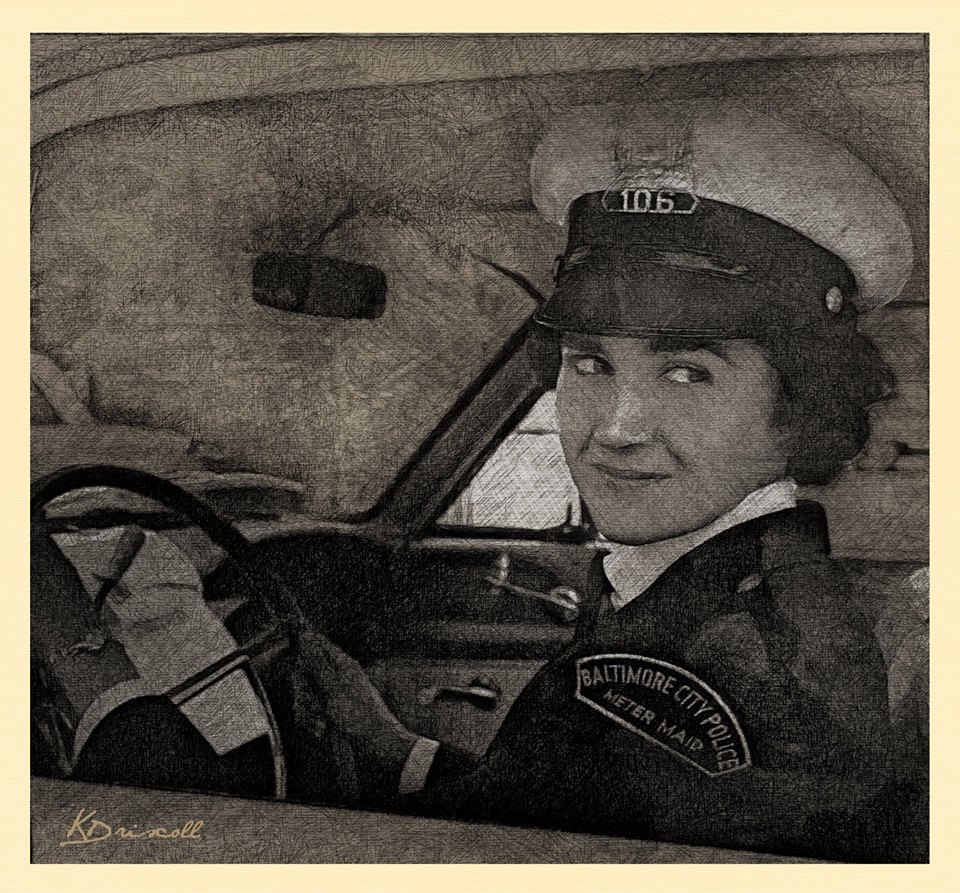
Mrs. Shirley Kurtz looks for parking meter violations as she drives. On the dashboard is a list of stolen cars, (BKA a Hot Sheet) Maids were making up to $4200 a year.
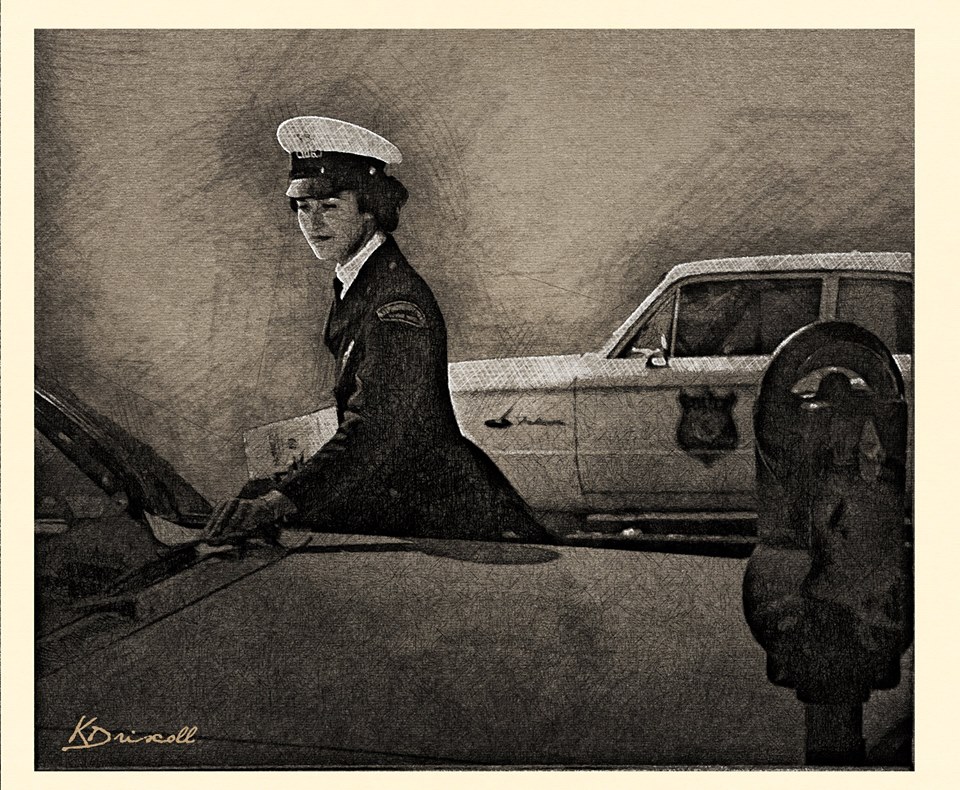
Mrs. Kurkz, one of the first ten meter maids hired, places a summons under the wiper blade. Last year, 68,515 tickets were issued by these ten Meter Maids. The fines ranging from $2.50 to $10.50
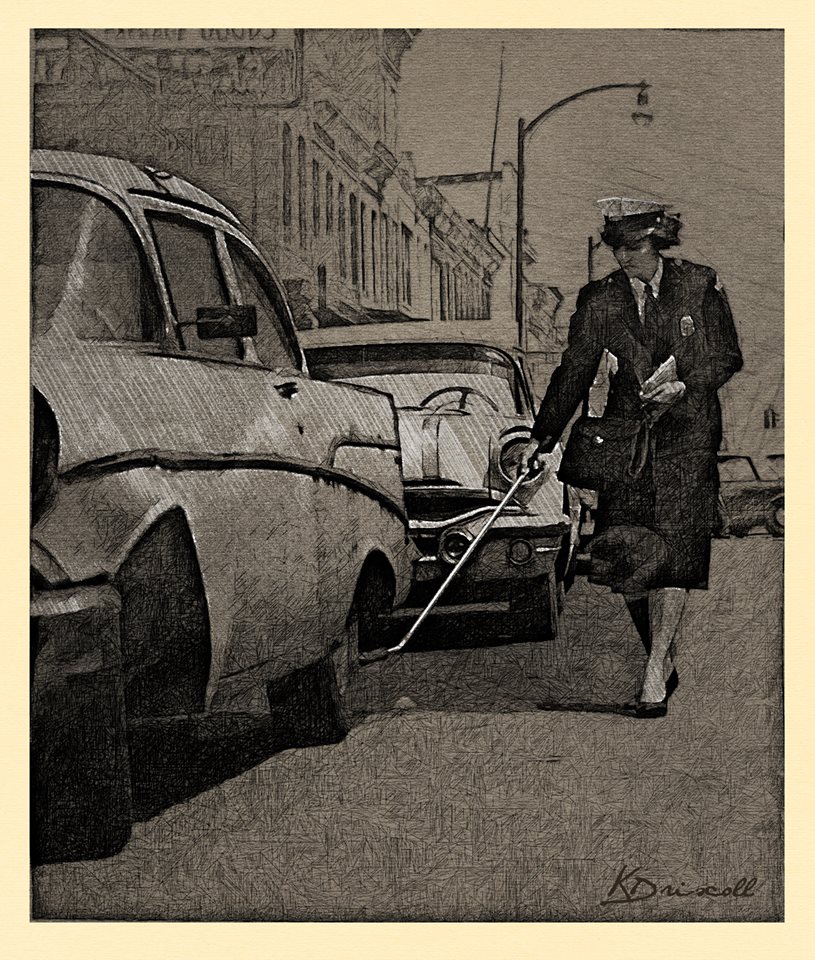
Some parking zones have no meter but are controlled by special signage. maids use bent rods to chalk tires of automobiles parked in such areas.
Meter Maids check their cars every morning, but they do it gingerly. Mrs. Angela M Chaney holds a tissue as she manipulates the dip-stick

The First Ten Meter Maids in Baltimore City
Front Row - Delores Nots, Joan Covert, Sheila McAlee, Shirley Boyley, Elizabeth Aro
Back Row- Betty Erwin, Annie George, Donna Lloyd, Lillian Hartlove, Shirley Kurtz
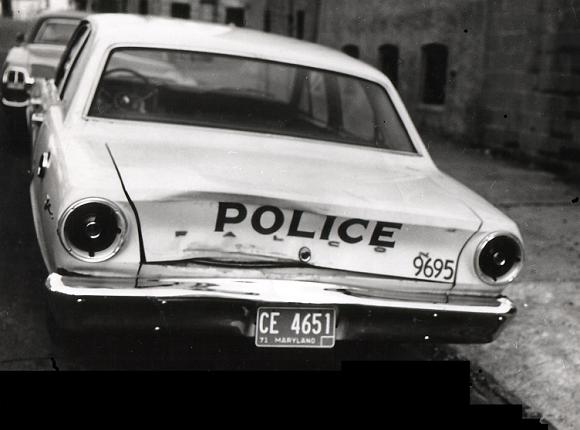
1967 Ford Falcon Meter Maid's Patrol Car

Pay by Plate Meters Replace Pay and Display Meters
Download Press Release
The Parking Authority has replaced Baltimore's old Pay and Display meters with Pay by License Plate meters using two vendors - IPS and Flowbird. With these new meters, you do not need to return to your car to display the receipt on your dash to avoid getting a ticket. Instead, you enter your license plate number, pay for the amount of time you'd like to park on that block, and go to your destination.
A total of 830 pay-by-plate meters have been installed. They still accept coins, credit, and debit cards. Parking duration limits and hours of operation have not changed.
Parkers who move their cars to another block are required to pay for another session at the parking meter on that block and must follow all posted parking restrictions.

FOR IMMEDIATE RELEASE
May 13, 2021
Press Contacts:
Tiffany James
Parking Authority of Baltimore City
This email address is being protected from spambots. You need JavaScript enabled to view it.
410-227-7517
German Vigil, Kathy Dominick
Baltimore City Department of Transportation
(410) 361-9296
Baltimore City Replaces On-Street Pay and Display Parking Meters
with Pay by License Plate Meters
Parkers No Longer Need to Display Receipt on Dash
BALTIMORE, MD — Mayor Brandon Scott along with the Parking Authority of Baltimore City and the Department of Transportation announced today that the last of the City’s on-street Pay and Display parking meters have been replaced with new Pay by License Plate parking meters.
Sometimes called EZ Park Meters, the old pay and display parking meters, which were installed beginning in 2004, required parkers to display a printed receipt on their dashboard to verify that they had paid for parking.
The new pay by license plate parking meters, which were installed beginning in 2019, do not require motorists to return to their vehicle and place the receipt on their dash. Instead, parkers enter the vehicle’s license plate number into the parking meter before paying for the time they wish to park. Parking enforcement agents, who are Department of Transportation employees, download real-time data from the parking meters into handheld devices that show which vehicles have paid for parking.
A total of 830 pay by plate meters have been installed. They still accept coins, credit, and debit cards. Parking duration limits and hours of operation have not changed.
“The first thing you do at the meter is enter your license plate number, so we recommend writing it down or taking a photo of your license plate number before you go to the parking meter,” Parking Authority Executive Director Pete Little said, “After you’ve used the meter, you can walk directly to your destination.”
Parking enforcement officers have been pleased with the new handheld devices provided by G-Techna. This new technology quickly provides parking enforcement with the data they need —which vehicles have paid for parking, within minutes. This means officers no longer have to search the vehicle’s dash for a receipt.
“We are excited to be using this new technology which brings parking enforcement up to date with modern equipment,” said Department of Transportation Director Steve Sharkey.
Parkers who move their cars to another block are required to pay for another session at the parking meter on that block and must follow all posted parking restrictions.
Should parkers need more information on how to use the new parking meters, please go to the Parking Authority website at https://parking.baltimorecity.gov/parking-meters.
About the Parking Authority of Baltimore City
Parking Authority of Baltimore City (PABC) is a quasi-governmental agency of Baltimore City and a registered 501c3 with a mission to find, or create, and implement parking solutions for Baltimore City, and to be the resource on all things "parking" in Baltimore. PABC oversees the management of 14 parking garages, numerous lots, over 800 parking meters, over 1,500 reserved residential handicap parking spaces, and 48 residential permit parking areas.
###

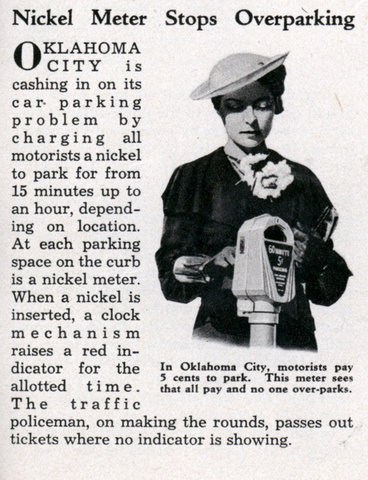
Parking Meter History

Donations
Donations help with web hosting, stamps and materials and the cost of keeping the website online. Thank you so much for helping BCPH.


POLICE INFORMATION
Copies of: Your Baltimore Police Department Class Photo, Pictures of our Officers, Vehicles, Equipment, Newspaper Articles relating to our department and or officers, Old Departmental Newsletters, Lookouts, Wanted Posters, and or Brochures. Information on Deceased Officers and anything that may help Preserve the History and Proud Traditions of this agency. Please contact Retired Detective Kenny Driscoll.
This email address is being protected from spambots. You need JavaScript enabled to view it.

NOTICE
How to Dispose of Old Police Items
Please contact Det. Ret. Kenny Driscoll if you have any pictures of you or your family members and wish them remembered here on this tribute site to Honor the fine men and women who have served with Honor and Distinction at the Baltimore Police Department.
Anyone with information, photographs, memorabilia, or other "Baltimore City Police" items can contact Ret. Det. Kenny Driscoll at This email address is being protected from spambots. You need JavaScript enabled to view it. follow us on Twitter @BaltoPoliceHist or like us on Facebook or mail pics to 8138 Dundalk Ave. Baltimore Md. 21222
Copyright © 2002 Baltimore City Police History - Ret Det Kenny Driscoll
































